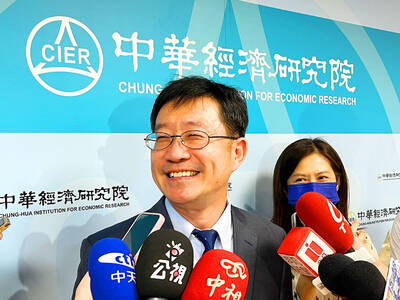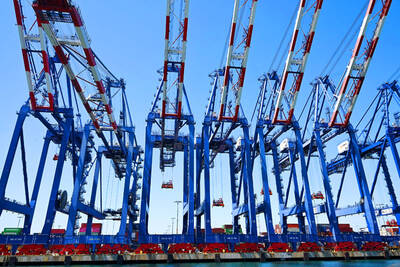The Philippine peso fell this week by the most in two months, leading losses among Asian currencies, on concern that record oil prices would quicken inflation and slow economic growth.
The peso slid for a sixth week after Economic Planning Secretary Augusto Santos said on Thursday that GDP growth in the first quarter probably slowed to as little as 5.2 percent because inflation at a three-year high restrained consumer spending. Oil prices reached US$135.09 yesterday, double what they were a year ago. South Korea’s won and Indonesia’s rupiah also slumped on demand for US dollars to fund oil imports.
“Inflation is definitely weighing on the economic outlook, not just in the first quarter but for the rest of the year,” said Vishnu Varathan, a regional economist at Forecast Singapore Pte. “That’s adding to the peso’s weakness.”
The peso fell 1.5 percent this week to 43.465 per US dollar as at 5pm in Manila, the Bankers Association of the Philippines said, the most since the five days ended March 14. The won dropped 0.7 percent to 1,047.65 per US dollar and the rupiah declined for a third week, to 9,313 per US dollar.
The Philippine economy may grow 6 percent in the first quarter, the slowest pace in six quarters, a survey compiled by Bloomberg News showed before a government report on May 29. Growth was 7.4 percent in the final quarter of last year.
Central bank Deputy Governor Diwa Guinigundo said on Thursday that the economy “will definitely suffer” if oil prices remain above US$125 a barrel. The country imports almost all of its domestic fuel needs.
South Korea’s won fell to 1,057.40 per US dollar on Wednesday, the lowest since October 2005, on concern oil prices will increase the nation’s import bill and slow economic growth. South Korea imports almost all of its oil needs and reported a fourth consecutive current account deficit in March.
“The driving force of the won’s weakness is oil,” said Kim Hee, a currency dealer at the state-run Korea Development Bank in Seoul. “The market has received hefty orders from importers” to settle deals in the US dollar.
Asia’s fourth-largest economy faces difficulties, including the recent surge in oil and raw material costs, Vice Finance Minister Choi Joong-kyung said in Seoul yesterday.
The economy will grow less than the central bank’s forecast of 4.7 percent because of higher oil costs and a global slowdown, Bank of Korea Deputy Governor Kim Byung-hwa said.
Indonesia’s rupiah fell after Energy Minister Purnomo Yusgiantoro said on Thursday that the government would raise domestic fuel prices by an average 29 percent to reduce its subsidies, prompting protests from students and labor unions.
Malaysia’s ringgit pared a weekly gain after the government said it would also cut subsidies.
“Investors are worried about the inflation outlook, which is why the Indonesian rupiah is weak,” said Goh Puay Yeong, a currency strategist in Singapore at Barclays Capital.
Malaysia plans to reduce fuel subsidies within two months, Second Finance Minister Nor Mohamed Yakcop said on Thursday.
“The risk to the ringgit and other regional currencies is the spike in inflation from the withdrawal of fuel subsidies,” said Suresh Kumar Ramanathan, a rates and currency strategist at CIMB Investment Bank Bhd in Kuala Lumpur.
The ringgit traded at 3.2175 per US dollar in Kuala Lumpur for a 0.5 percent gain on the week.

WEAKER ACTIVITY: The sharpest deterioration was seen in the electronics and optical components sector, with the production index falling 13.2 points to 44.5 Taiwan’s manufacturing sector last month contracted for a second consecutive month, with the purchasing managers’ index (PMI) slipping to 48, reflecting ongoing caution over trade uncertainties, the Chung-Hua Institution for Economic Research (CIER, 中華經濟研究院) said yesterday. The decline reflects growing caution among companies amid uncertainty surrounding US tariffs, semiconductor duties and automotive import levies, and it is also likely linked to fading front-loading activity, CIER president Lien Hsien-ming (連賢明) said. “Some clients have started shifting orders to Southeast Asian countries where tariff regimes are already clear,” Lien told a news conference. Firms across the supply chain are also lowering stock levels to mitigate

IN THE AIR: While most companies said they were committed to North American operations, some added that production and costs would depend on the outcome of a US trade probe Leading local contract electronics makers Wistron Corp (緯創), Quanta Computer Inc (廣達), Inventec Corp (英業達) and Compal Electronics Inc (仁寶) are to maintain their North American expansion plans, despite Washington’s 20 percent tariff on Taiwanese goods. Wistron said it has long maintained a presence in the US, while distributing production across Taiwan, North America, Southeast Asia and Europe. The company is in talks with customers to align capacity with their site preferences, a company official told the Taipei Times by telephone on Friday. The company is still in talks with clients over who would bear the tariff costs, with the outcome pending further

NEGOTIATIONS: Semiconductors play an outsized role in Taiwan’s industrial and economic development and are a major driver of the Taiwan-US trade imbalance With US President Donald Trump threatening to impose tariffs on semiconductors, Taiwan is expected to face a significant challenge, as information and communications technology (ICT) products account for more than 70 percent of its exports to the US, Chung-Hua Institution for Economic Research (CIER, 中華經濟研究院) president Lien Hsien-ming (連賢明) said on Friday. Compared with other countries, semiconductors play a disproportionately large role in Taiwan’s industrial and economic development, Lien said. As the sixth-largest contributor to the US trade deficit, Taiwan recorded a US$73.9 billion trade surplus with the US last year — up from US$47.8 billion in 2023 — driven by strong

RESHAPING COMMERCE: Major industrialized economies accepted 15 percent duties on their products, while charges on items from Mexico, Canada and China are even bigger US President Donald Trump has unveiled a slew of new tariffs that boosted the average US rate on goods from across the world, forging ahead with his turbulent effort to reshape international commerce. The baseline rates for many trading partners remain unchanged at 10 percent from the duties Trump imposed in April, easing the worst fears of investors after the president had previously said they could double. Yet his move to raise tariffs on some Canadian goods to 35 percent threatens to inject fresh tensions into an already strained relationship, while nations such as Switzerland and New Zealand also saw increased